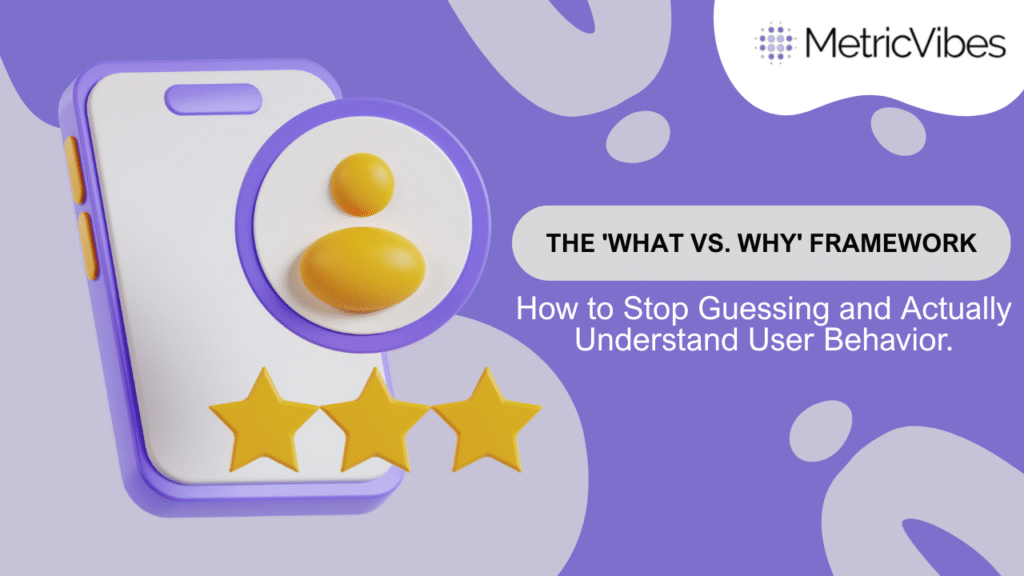The 'What vs. Why' Framework: How to Stop Guessing and Actually Understand User Behavior
In today’s data-driven landscape, understanding user behavior is paramount and Unlocking Actionable User Insights.
While quantitative data paints a picture of what users are doing (clicks, page views, conversion rates), it rarely reveals the crucial why behind those actions. Without understanding the motivations driving user interactions, we’re left guessing at the best way to optimize experiences and drive desired outcomes.
This is where the “What vs. Why” framework comes into play. It provides a structured approach to bridge the gap between raw data and actionable insights, empowering you to move beyond speculation and towards data-informed decision-making.

Stage 1: Building Your Foundation (Quantitative Data Mastery)
The foundation of any effective user behavior analysis is robust quantitative data collection. This means implementing comprehensive website analytics to track key metrics like conversion rates, bounce rates, time on page, and user flow through funnels.
Leveraging platforms like Google Analytics 4 (GA4) provides a wealth of data, enabling you to identify critical drop-off points and bottlenecks in the user journey.
This stage focuses on answering the “what” questions:
What are users doing on our site?
What are the current conversion rates?
What are the most common paths users take?
Stage 2: Illuminating the "Why" (Qualitative Data Integration)
Once you have a solid grasp of the “what,” it’s time to delve into the “why.”
This requires integrating qualitative data collection methods to understand the motivations and context behind user actions.
Tools like heatmaps and session recordings offer invaluable visual insights into how users interact with specific pages, revealing points of friction, hesitation, or confusion that quantitative data alone can’t uncover.
Supplement this with user surveys and feedback forms to directly capture user perspectives and understand their needs, pain points, and expectations.
For example:
If your funnel analysis reveals a high drop-off rate on a particular product page, heatmaps and session recordings can pinpoint whether users are struggling with navigation, unclear product information, or a confusing call-to-action.
Stage 3: Synthesizing Insights and Driving Action (CRO Strategy)
The true power of the “What vs. Why” framework lies in synthesizing both qualitative and quantitative data to drive actionable changes.
By combining the “what” with the “why,” you gain a holistic understanding of user behavior, empowering you to optimize every step of the user journey.
This could involve refining website navigation, clarifying product descriptions, repositioning calls-to-action, or even rethinking the entire user interface based on observed behavior patterns.
Remember: the goal is not just to collect data, but to use it to improve the user experience, boost conversion rates, and ultimately achieve business objectives.
For instance:
If session recordings reveal users struggling to locate specific security clauses in a lengthy document during the sales process, implementing a searchable internal knowledge base could significantly streamline the sales cycle.
Stage 4: Continuous Optimization and Governance (Data-Driven Culture)
User behavior is constantly evolving, which means your analysis and optimization efforts should be continuous.
Regularly review your data, conduct A/B testing, and iterate on your strategies based on the insights you gather.
Furthermore, establishing a robust data governance framework is crucial. This ensures data quality, consistency, and ethical considerations are prioritized throughout the entire process, fostering trust and transparency within your organization.
Conclusion: Unlocking Actionable User Insights
The “What vs. Why” framework provides a structured approach to understanding user behavior, moving beyond surface-level metrics to uncover the motivations driving user interactions.
By combining quantitative and qualitative data, you unlock actionable insights to optimize user experiences, boost conversion rates, and drive business growth.
Start by assessing your current data collection practices and identify areas where you can integrate qualitative research methods. Embrace a data-driven culture and empower your organization to make informed decisions based on a true understanding of user behavior.
FAQ Section
Consider your specific needs and budget. Tools like heatmaps and session recordings are excellent for visualizing user behavior, while surveys and user interviews provide direct feedback.
Regular review is key. Establish a cadence that aligns with your business objectives—whether it’s weekly, monthly, or quarterly. Continuously monitoring data allows you to identify emerging trends and adapt your strategies accordingly.
Reach out for tailored analytics and personalization solutions for your business by us. Contact Here


I have been browsing online more than three hours today yet I never found any interesting article like yours It is pretty worth enough for me In my view if all website owners and bloggers made good content as you did the internet will be a lot more useful than ever before